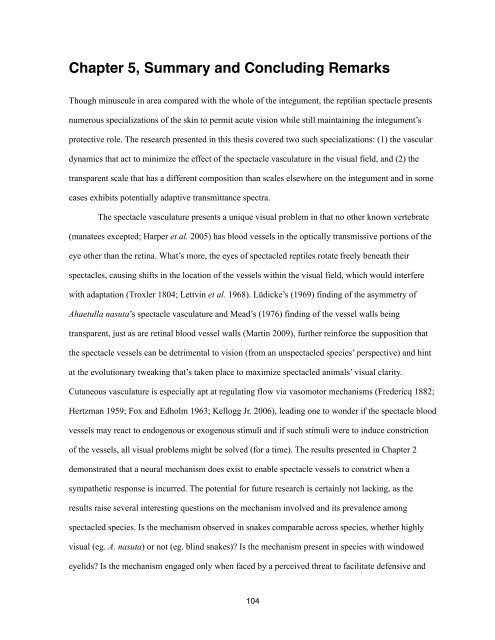Chapter 1, The Reptilian Spectacle - UWSpace - University of ...
Chapter 1, The Reptilian Spectacle - UWSpace - University of ...
Chapter 1, The Reptilian Spectacle - UWSpace - University of ...
Create successful ePaper yourself
Turn your PDF publications into a flip-book with our unique Google optimized e-Paper software.
<strong>Chapter</strong> 5, Summary and Concluding Remarks<br />
Though minuscule in area compared with the whole <strong>of</strong> the integument, the reptilian spectacle presents<br />
numerous specializations <strong>of</strong> the skin to permit acute vision while still maintaining the integument’s<br />
protective role. <strong>The</strong> research presented in this thesis covered two such specializations: (1) the vascular<br />
dynamics that act to minimize the effect <strong>of</strong> the spectacle vasculature in the visual field, and (2) the<br />
transparent scale that has a different composition than scales elsewhere on the integument and in some<br />
cases exhibits potentially adaptive transmittance spectra.<br />
<strong>The</strong> spectacle vasculature presents a unique visual problem in that no other known vertebrate<br />
(manatees excepted; Harper et al. 2005) has blood vessels in the optically transmissive portions <strong>of</strong> the<br />
eye other than the retina. What’s more, the eyes <strong>of</strong> spectacled reptiles rotate freely beneath their<br />
spectacles, causing shifts in the location <strong>of</strong> the vessels within the visual field, which would interfere<br />
with adaptation (Troxler 1804; Lettvin et al. 1968). Lüdicke’s (1969) finding <strong>of</strong> the asymmetry <strong>of</strong><br />
Ahaetulla nasuta’s spectacle vasculature and Mead’s (1976) finding <strong>of</strong> the vessel walls being<br />
transparent, just as are retinal blood vessel walls (Martin 2009), further reinforce the supposition that<br />
the spectacle vessels can be detrimental to vision (from an unspectacled species’ perspective) and hint<br />
at the evolutionary tweaking that’s taken place to maximize spectacled animals’ visual clarity.<br />
Cutaneous vasculature is especially apt at regulating flow via vasomotor mechanisms (Fredericq 1882;<br />
Hertzman 1959; Fox and Edholm 1963; Kellogg Jr. 2006), leading one to wonder if the spectacle blood<br />
vessels may react to endogenous or exogenous stimuli and if such stimuli were to induce constriction<br />
<strong>of</strong> the vessels, all visual problems might be solved (for a time). <strong>The</strong> results presented in <strong>Chapter</strong> 2<br />
demonstrated that a neural mechanism does exist to enable spectacle vessels to constrict when a<br />
sympathetic response is incurred. <strong>The</strong> potential for future research is certainly not lacking, as the<br />
results raise several interesting questions on the mechanism involved and its prevalence among<br />
spectacled species. Is the mechanism observed in snakes comparable across species, whether highly<br />
visual (eg. A. nasuta) or not (eg. blind snakes)? Is the mechanism present in species with windowed<br />
eyelids? Is the mechanism engaged only when faced by a perceived threat to facilitate defensive and<br />
104
















